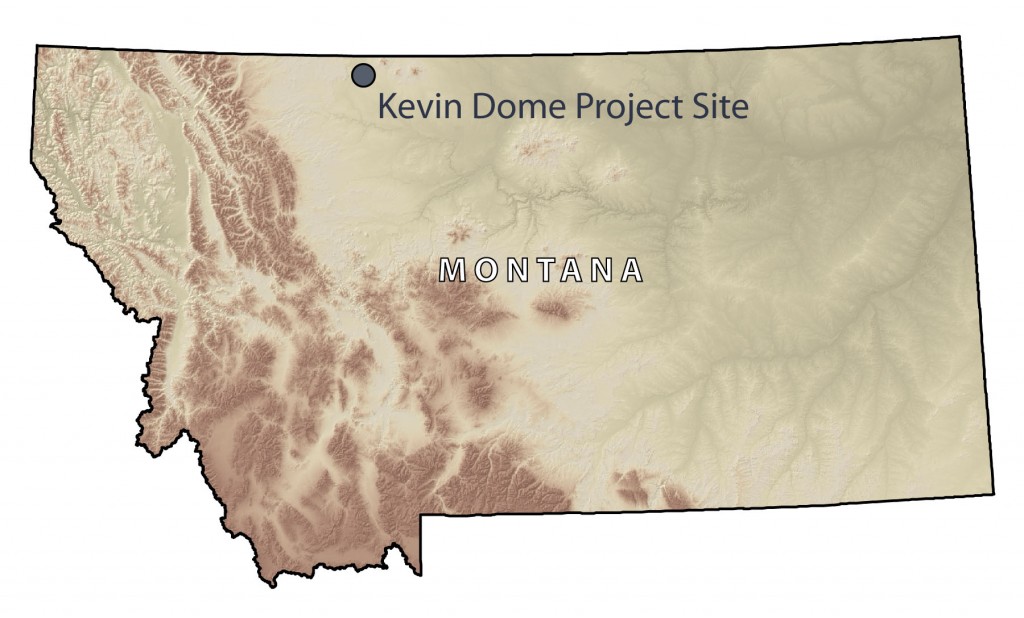The quest to reduce carbon emissions is coming to Big Sky country. Scientists from Lawrence Berkeley National Laboratory (Berkeley Lab) are part of an effort to determine whether a large fraction of Montana’s and nearby states’ CO2 emissions can be stored deep underground — where it can’t contribute to climate change.

Schematic illustration of carbon capture and storage at Kevin Dome in Montana. Courtesy Big Sky Carbon Sequestration Partnership
The project was finalized this summer, when Montana State University cemented an agreement with the U.S. Department of Energy to begin work on an $85 million, eight-year project that will involve injecting one million tons of CO2 over four years into an underground rock formation in north-central Montana.
The porous rock formation is called Kevin (pronounced kee-vin) Dome, a 700-square-mile subsurface geologic feature that has trapped naturally occurring CO2 for millions of years. Rock layers above the CO2 prevent gas and other fluids from migrating to the surface.
The project will help scientists determine if Kevin Dome is a viable and safe repository for the region’s CO2 emissions.
Geologic carbon sequestration holds promise to help mitigate climate change by capturing CO2 from major sources, such as coal-burning power plants, and injecting it deep underground for permanent storage. The technology is being developed because fossil fuels will likely remain cheap and plentiful for decades to come, even as renewable energy sources such as wind and solar continue to improve.
In addition to Berkeley Lab and Montana State University, the Kevin Dome project involves several universities, companies, and national labs. It’s part of the Big Sky Carbon Sequestration Partnership, one of seven partnerships in the U.S. Department of Energy’s Regional Carbon Sequestration Partnerships program. These partnerships are developing the technology to implement large-scale CO2 sequestration throughout the U.S.
The Big Sky partnership will drill wells to extract CO2 from Kevin Dome, transport it by pipeline several miles, and then inject it 3,500 feet below ground into the flank of the dome, which contains mostly saline water.
All of this will require extensive modeling, monitoring and lab analyses, which is where Berkeley Lab comes in. It’s receiving $5.6 million from the project and is a key player in the partnership. Geologist Curt Oldenburg, who heads Berkeley Lab’s Geologic Carbon Sequestration Program in the Earth Sciences Division, and hydrogeologist Quanlin Zhou, also with the Earth Sciences Division, lead the Lab’s participation.
“We’ve been involved in geologic carbon sequestration research since 1998. In this project, we’ll assist with computer modeling and simulations, monitoring, sampling, and laboratory measurements of core samples,” says Oldenburg.
Berkeley Lab is involved in several other geologic carbon sequestration demonstration projects worldwide, such as the Otway Project in Australia and at the Frio formation in Texas. But Kevin Dome offers a unique opportunity.
“The site may provide an excellent natural analogue of geologic carbon sequestration because reactions between CO2, water, and rock, and residual CO2 trapping, have been going on for millennia during migration in Kevin Dome,” says Zhou.
At Kevin Dome, Oldenburg, Zhou and colleagues will use the TOUGH computer codes developed at Berkeley Lab to model the CO2 plume at various stages. The codes model CO2-water-rock reactions and geomechanical impacts such as caprock integrity and induced seismicity and microseismicity.
Before injection, their simulations will help predict where the plume will go once the project begins. During injection, they’ll modify their models to reflect what is actually happening underground using real-time monitoring data. And after injection is completed in 2017, their simulations will project what the plume will look like in the decades to come.
Berkeley Lab scientists will also assist in the design and deployment of monitoring instrumentation to track the plume, using both surface and subsurface approaches. And in the laboratory, Berkeley Lab scientists will conduct measurements of fluid flow in core samples taken from the site.
Ultimately, their research will help scientists assess whether formations like Kevin Dome can play a significant role in future carbon sequestration projects.
“This work will have impacts beyond Kevin Dome because the models that we use will be improved and verified,” says Oldenburg. “What we learn at Kevin Dome can be expected to occur in other potential sequestration sites with similar characteristics.”
# # #
Lawrence Berkeley National Laboratory addresses the world’s most urgent scientific challenges by advancing sustainable energy, protecting human health, creating new materials, and revealing the origin and fate of the universe. Founded in 1931, Berkeley Lab’s scientific expertise has been recognized with 13 Nobel prizes. The University of California manages Berkeley Lab for the U.S. Department of Energy’s Office of Science. For more, visit www.lbl.gov.
Additional information:
- More about Berkeley Lab’s Geologic Carbon Sequestration Program
- More about the Kevin Dome Large-Scale Storage Project
- More about the Big Sky Carbon Sequestration Partnership
